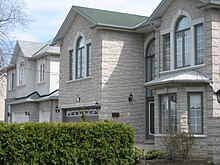Neo-eclectic architecture



Neo-eclectic architecture is a name for an architectural style that has influenced residential building construction in North America in the latter part of the 20th century and early part of the 21st. It is a contemporary version of Revivalism that has perennially occurred since Neoclassical architecture developed in the mid 18th century.
In contrast to the occasionally faux and low-budget Neo-Eclectic detached homesteads, the term New Classical architecture identifies contemporary buildings that stick to the basic ideals, proportions, materials and craftsmanship of traditional architecture.
Characteristics
Neo-eclectic architecture combines a wide array of decorative techniques taken from an assortment of different house styles. It can be considered a devolution from the clean and unadorned
Applications
In Neo-Eclectic architecture the revival elements are almost always decorative, consisting of surface elements such as claddings and windows. Details such as heavy moldings and/or trim (that would be cut stone or plaster in traditional architecture) are usually extruded foam with a stucco veneer. Aside from specifications adjusted for lower quality, newer growth lumber, the basic construction of Neo-Eclectic houses is unchanged from previous house styles such as the ranch-style house. An important development leading to the modern Neo-Eclectic style is the popularity of
Critiques

Neo-eclectic architecture is most prominent in what are pejoratively known as
Critics of Neo-Eclectic architecture see the style as pretentious, wasteful and/or garish, and unoriginal.[3] Typically and somewhat deceptively, the Neo-Eclectic style plays an instrumental role in making cheaply built, over-sized tract homes on comparatively small parcels of land appear as something far greater than the sum of their parts.
See also
- New Classical Architecture, a more accurate reference style to historical architecture.
- Neomodern architecture, a current modernist response.
- Sustainable architecture
- Sustainable development
- Sustainable design
- Snout house
- Mar del Plata style, an Argentine 20th century eclectic style
References
- ^ "What Not to Build: Do's and Don'ts of Exterior Home Design." By Sandra Edelman, Judith Kay Gaman, Judy Gaman, Robby Reid, Creative Homeowner Press.
- ^ Frank, Thomas. "Let them eat McMansions! The 1 percent, income inequality, and new-fashioned American excess". Salon. Retrieved 25 April 2014.
- ^ Cathleen McGuigan, The Mcmansion Next Door, Newsweek, October 27, 2003. Retrieved on 2008-10-26.
